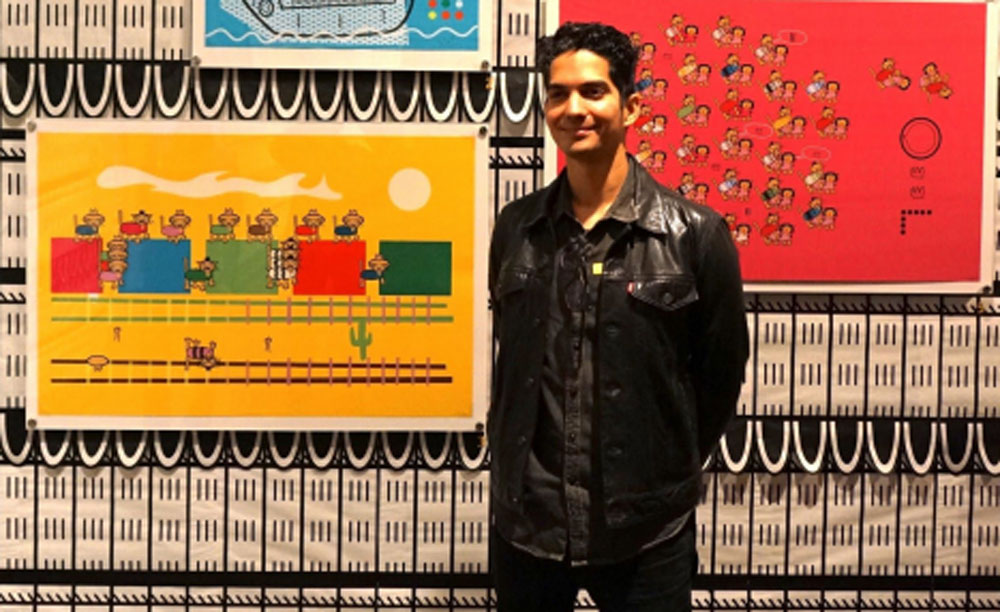San Antonian Michael Menchaca is one of the bright stars of the Latino art movement. His beautiful prints are well represented in the Smithsonian American Art Museum in Washington, DC exhibit, !Printing The Revolution: The Rise and Impact of Chicano Graphics. This fabulous exhibition, with 120 prints, opens this week and is available now for virtual viewing. There are 12 of Menchaca’s prints included in the Smithsonian exhibit and in the beautiful 340 page catalogue book of the show.
Menchaca’s first inclusions in art exhibitions date back to 2010, but in the last five years, his prints and videos have been included in exhibitions in New York, California, Massachusetts, Rhode Island, Nebraska, Colorado, Oklahoma, Illinois, Missouri, Washington, Hawaii, Texas, North Carolina, and Connecticut. The prestigious Artpace International Program in San Antonio recently selected Menchaca as an Artist-in-Residence.
Michael Menchaca grew up in the Northeast section of San Antonio and studied graphic arts at San Antonio College. His approach to the arts changed when he enrolled at Texas State University in San Marcos, 45 miles from San Antonio. At the San Marcos campus, he discovered a new passion for the creative arts and printmaking. His grounding in the creative arts was solidified when he attended the Rhode Island School of Design, where he earned a master’s degree in 2015.
Menchaca frames his images based on historical events and anthropological interpretations. For instance, he makes extensive use of the Mayan and Aztec systems of writing and uses pre Columbian figures and texts common to Mexican Indian codices. He dramatizes these images and figures in his effort to address contemporary issues on race relations, politics, and social justice.
Menchaca print: “Codex Borgia.” Donated to the Smithsonian American Art Museum and Univ. of Houston Downtown Campus by Harriett and Ricardo Romo.
In a print titled “Hasta La Casta,” which is a play on words from the phrase “Hasta La Vista,” Menchaca delves deeply into Spanish colonial history in the aftermath of the conquest of Mexico when conquerors created a caste system referred to as “Castas.” The matrix of Castas included Mestizos, Mulatos, Indios, and Coyotes, to name a few of the fifty-four racial and ethnic categories.
Menchaca print. Donated to the Smithsonian American Art Museum and Univ. of Houston Downtown Campus by Harriett and Ricardo Romo.
Menchaca includes animated coyote figures with different skin tones to show the blurred boundaries of such Casta categorizations. As we learn from the contemporary daily news, there is ample human tragedy along the U.S. southern border with Mexico. In prints selected for the 2018 McNay exhibit, Menchaca utilizes cats as well as other animals to document the struggle and difficulties that migrants face as they contract human “coyotes” to cross the border,
fight off narcos, and try to evade apprehension by the Border Patrol.
Menchaca strives to present cultural events through invented mythology. In many of his earlier works, he acknowledges using animal archetypes such as cats and dogs “to tell stories of class inequality, civil rights cases, and the distribution of privileges within the Americas.”
In an interview I had with Mechaca last year, he noted: “ I try to bring various influences to bear on the imagery…contemporary cartoons and animation, ancient writing systems, racial identity and humor.” His print, “Cuando El Rio Suena Gatos Lleva,” addressed the issue of Mexican migration to the United States. In this piece, included in a 2019 McNay Art Museum solo exhibit of his work, Menchaca portrayed cats wearing sombreros swimming across a wide Rio Grande.
Michael Menchaca: McNay Art Museum solo exhibition. 2019. Includes prints donated by Harriett and Ricardo Romo. Photo: Ricardo Romo
Many San Antonians who follow the arts first became acquainted with Menchaca’s iconic prints following his inclusion in the Estampas De La Raza exhibit at the McNay Art Museum in 2016. The Estampas exhibit included 46 outstanding Latino and Latina artists from across the country, along with Menchaca’s print of cats crossing the Rio Grande. The Estampas exhibit, which traveled to Los Angeles, Albuquerque, Chicago, and Raleigh, represented a portion of a gift of 200 Latino prints to the McNay from the Harriett and Ricardo Romo collection.
In the last several years Menchaca has expanded on his themes and images. He explained that the cat motif opened “the doors for me to explore my cultural heritage, racial tension, stories of immigration, all with a sense of levity, while formally connecting to the ancient representational traditions of the American continent.”
When Ruiz-Healy gallery owner and collector Dr. Patricia Ruiz-Healy interviewed Menchaca last year, the artist explained: “We must initiate a new wave of Chicano imagery expressing our collective concerns in the present age. We must rise past a reliance on sociological and cultural generalizations regarding Chicano art and insist on more comprehensive art interpretation.”
Menchaca has indeed introduced Latino art aficionados to new imagery, an imagery that comes alive in prints and videos.
Mexican American Artist Menchaca Shines in New Smithsonian Exhibition









